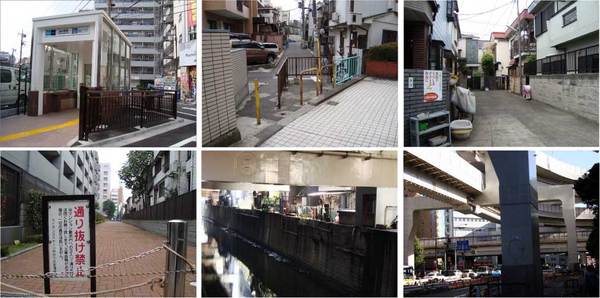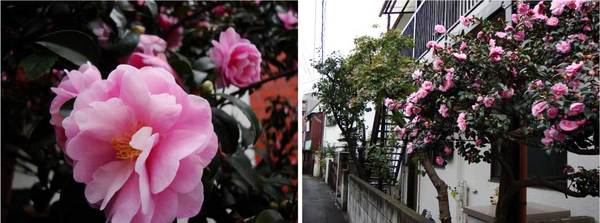"Do you really think Tokyo is green? Why do you only focus on the good sides of Tokyo?" These are questions that many Japanese and foreign residents of Tokyo have asked me.
Tokyo Green Space focuses on how residents of the world's largest city make the most of a poorly planned and dense city by gardening in the smallest of spaces. There is a growing awareness that making maximum use of public spaces in cities offers tremendous human and environmental benefits. But the questions I have been asked reflect the persistent gap between what is and what can be.
While celebrating grassroots ingenuity and overturning expectations, Tokyo Green Space would do a disservice if it ignored the many examples of how dead space continues to be created by public authorities, large property developers, and ordinary land-owners. What motivates organizations and people to construct urban dead spaces? What can be done to reclaim these spaces for people and nature?
Tokyo contains many contradictions. You can focus on a brilliant pink camellia blossom in winter, marvel at its outrageous beauty, and consider how this plant is tended by a local gardener or perhaps thriving due to Tokyo's temperate climate. Or you can look at the wider context, and wonder why are there so many hideous cinder block walls, excessive street pavement, and inadequate tree canopy?
Dead urban spaces actively discourage life--human, plant, and animal life--with hard surfaces and restricted access. Contrary to popular opinion, cities only become devoid of natural life by active suppression: burying soil and rivers below pavement, and imagining our lives as separate from natural cycles.
In my daily life in Tokyo, I often encounter these dead spaces. Here are some examples.
- Tokyo Metro recently constructed an elevator entrance for disabled access at a nearby subway station. A sleek structure with a glass roof occupies most of an odd shaped, small lot. The remaining triangular area is cut off by a brown metal fence and topped with asphalt, probably to prevent bicycle parking.
- The border between a small street and a pedestrian alley has metal poles to prevent car access, and also another triangle of brown metal fence. In fact, there are three distinct sets of dividers separating these two paths.
- The area between six residential buildings is covered in concrete, and sits barren. It is not clear whether this space is public or private, for cars, bicycles or storage, or if it serves any purpose at all.
- A relatively new apartment building has a wide alley, presumably for fire access. The alley has a chain across the entrance to prevent access. The developers adhered to building rules requiring access for emergency vehicles. Yet for most, if not all of the year, neither residents nor neighbors set foot on the alley.
- Tokyo was once a city of canals, with boats transporting all heavy goods during the Edo period. Now the canals and most of the rivers are either buried in concrete, shadowed by freeways, or lowered 4 to 5 meters below street level in concrete chutes to prevent flooding.
- Elevated highways cut through many districts in central Tokyo. Perhaps none is worse than the four, stacked expressways in front of Shinjuku's Opera City. These highways create dead spaces below them, generate noise and air pollution, and divide neighborhoods.

Figure 2: (Top row, left to right) Tokyo Metro elevator entrance; barrier between small street and pedestrian path; paved residential space; (Bottom row, left to right) no access alley; shadowed river; four layers of freeway
During the twentieth century's rapid urbanization and development, pouring concrete was a marker of modernity, a source of profits and at times corruption. Increasing vehicle throughput seemed like progress at the time. Few objected to prioritizing private automobiles powered by fossil fuels over other human and natural activities.
Bureaucratic inertia and popular indifference ensure that public and private money continues to be spent to maintain and even expand dead spaces. What would it take to reverse the tide? Environmental, economic, and educational arguments can each be made to bring new life to the city. In terms of the environment, it is becoming increasingly clear that the trend to urbanization is accelerating and will soon include billions of people in developing nations. Growing an urban forest mitigates climate change, lowers summer air temperature, cleans the air, encourages more efficient transit, brings agriculture into the city, and allows more people to live well with finite resources.
Economic policies can also encourage better choices by individuals and organizations. Currently the true cost of concrete and asphalt is externalized, which falsely makes pavement seem less costly to build and repair. For private and public property, local and national governments can use many levers to place a fair economic value on urban space. Rebates and concessions would encourage landowners to uncover soil, increase plant material, and create new, shared spaces. Usage fees and assessments could reduce the quantity of cinderblock walls and metal fences, limit private automobiles in cities, and discourage dead zones that restrict human and wildlife access.
Streets constitute the largest open spaces in urban areas, and some cities are now reducing automobiles and pavement to generate new public benefits for their residents. Portland, Oregon and San Francisco are de-paving and planting native plants to catch storm water that would otherwise flow into sewage treatment plants that are costly to maintain. Exposing urban soil will dramatically increase plant bio-mass, creating wildlife habitat and new places for city people to enjoy. Outstanding public spaces, including green corridors and micro-parks, allow cities to attract highly educated and mobile residents and visitors.
Ultimately, I believe that education-- or rather imagination-- is the key to remaking our urban life. Education has connotations of top-down messages or doing what is right. The imagination may be a more powerful motivator that harnesses ordinary people's desires to improve their everyday lives and environments.
Exceptional artists like Japanese animator Miyazaki Hayao have created remarkable illustrations of how a city "where Totoro lives" could be built on top of Tokyo's existing urban structure. The role of beauty and art in inspiring change cannot be underestimated. With public and private backing, contests could promote visionary green space concepts, and demonstration projects could reveal the full potential of today's underutilized streets, walls and rivers.
Along with showcasing new ideas, ordinary citizens who are already making their neighborhoods greener with micro-gardens deserve greater public recognition and resources. City gardeners, bird watchers, beekeepers, and neighborhood volunteers have the knowledge and passion to make urban life better.
Urban dead space can be easily and economically transformed into living habitat, connecting our urban lives to the natural world. To change our cities, we must demand better of our leaders and our surroundings.
Jared Braiterman PhD writes a blog about Tokyo Green Space, and his research has been published in Japan, China, Europe, Latin America, and the United States.
